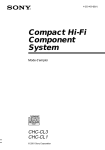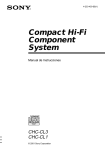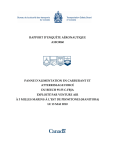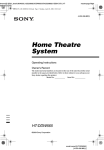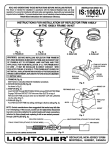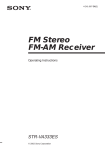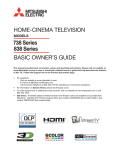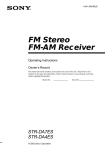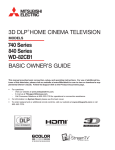Download Sony CHC-CL1 CD Shelf System
Transcript
4-233-430-13(1) Compact Hi-Fi Component System Operating Instructions Owner’s Record The model and serial numbers are located on the rear panel of the unit. Record the serial number in the space provided below. Refer to them whenever you call upon your Sony dealer regarding this product. Model No. CHC-CL3 CHC-CL1 © 2001 Sony Corporation Serial No. Warning This symbol is intended to alert the user to the presence of uninsulated “dangerous voltage” within the product’s enclosure that may be of sufficient magnitude to constitute a risk of electric shock to persons. To prevent fire or shock hazard, do not expose the unit to rain or moisture. To avoid electrical shock, do not open the cabinet. Refer servicing to qualified personnel only. To prevent fire, do not Cover the ventilation of the apparatus with news papers, table-cloths, curtains, etc. And don’t place lighted candles on the apparatus. To prevent fire or shock hazard, do not place vases on the apparatus. Do not install the appliance in a confined space, such as a bookcase or built-in cabinet. This symbol is intended to alert the user to the presence of important operating and maintenance (servicing) instructions in the literature accompanying the appliance. CAUTION The use of optical instruments with this product will increase eye hazard. This appliance is classified as a CLASS 1 LASER product. The CLASS 1 LASER PRODUCT MARKING is located on the rear exterior. The following caution label is located inside the apparatus. Don’t throw a battery, dispose it as the injurious wastes. WARNING This equipment has been tested and found to comply with the limits for a Class B digital device, pursuant to Part 15 of the FCC Rules. These limits are designed to provide reasonable protection against harmful interference in a residential installation. This equipment generates, uses, and can radiate radio frequency energy and, if not installed and used in accordance with the instructions, may cause harmful interference to radio communications. However, there is no guarantee that interference will not occur in a particular installation. If this equipment does cause harmful interference to radio or television reception, which can be determined by turning the equipment off and on, the user is encouraged to try to correct the interference by one or more of the following measures: – Reorient or relocate the receiving antenna. – Increase the separation between the equipment and receiver. – Connect the equipment into an outlet on a circuit different from that to which the receiver is connected. – Consult the dealer or an experienced radio/TV technician for help. CAUTION You are cautioned that any changes or modifications not expressly approved in this manual could void your authority to operate this equipment. NOTICE FOR THE CUSTOMERS IN THE U.S.A. ENERGY STAR® is a U.S. registered mark. As an ENERGY STAR® Partner, Sony Corporation has determined that this product meets the ENERGY STAR® guidelines for energy efficiency. 2 Table of Contents Parts Identification Main unit ................................................... 4 Remote Control ......................................... 5 Getting Started Hooking up the system .............................. 6 Inserting two R6 (size AA) batteries into the remote .................................... 7 Setting the time ......................................... 8 Saving the power in standby mode ........... 8 Tape – Recording Recording a CD on a tape — CD-TAPE Synchro Recording/ Tape Select Edit ................................ 18 Recording on a tape manually — Manual Recording ....................... 19 Timer recording radio programs ............. 19 Sound Adjustment Adjusting the sound — GROOVE/DBFB ......................... 20 Selecting the preset music menu ............. 21 CD Loading a CD ............................................ 9 Playing a CD — Normal Play/Shuffle Play/ Repeat Play ......................................... 9 Programing CD tracks — Program Play ............................... 11 Using the CD display .............................. 12 Labeling a CD — Disc Memo ................ 12 Timer Falling asleep to music — Sleep Timer ................................. 22 Waking up to music — Daily Timer ................................. 22 Optional Components Tuner Presetting radio stations .......................... 14 Listening to the radio — Preset Tuning ............................... 15 Labeling the preset stations — Station Name ............................... 16 Using the Radio Data System (RDS)* .... 16 Tape – Play Hooking up the optional components ..... 23 Additional Information Precautions .............................................. 24 Troubleshooting ...................................... 26 Messages ................................................. 29 Specifications .......................................... 29 * European model only Loading a tape ......................................... 17 Playing a tape .......................................... 17 3 Parts Identification The items are arranged in alphabetical order. Refer to the pages indicated in parentheses for details. Main unit 1 2 3 4 wf wd ws wa w; ql qk qj 5 6 7 8 qh qg 9 qf BASS/TREBLE ws (21) CD 1 – 3 qd (11) CD 1 – 3 Z qd (9) CD disc tray qf (9) CD SYNC ql (18) CD NX 8 (9) DBFB wa (20) DIMMER qg (7) DISPLAY wd (8, 12) Display window 3 EDIT w; (18) FUNCTION qs (9, 17, 18) GROOVE qj (20) MD 0 (24) MUSIC MENU ws (21) 4 qd qsqa 0 PHONES jack 9 PLAY MODE/DIRECTION qk (9, 17, 18) REC PAUSE/START ql (18, 19) Remote sensor wf REPEAT qh (10) STEREO/MONO qh (15) Tape deck lid 2 (17) TAPE nN qa (17, 18) TUNER/BAND 7 (14, 15) VOLUME 5 BUTTON DESCRIPTIONS ?/1 1 ./> 4 x6 m/M ws +/– ws Remote Control Parts Identification 1 2 34 ws wa 5 6 7 8 9 0 qa qs w; qd ql qk qf qg qj qh wh wg wf wd CHECK 8 (11) CLEAR qs (11) CLOCK/TIMER SELECT 2 (20, 23) CLOCK/TIMER SET 3 (8, 19, 22) DBFB wh (20) DIMMER wd (7) DISC SKIP 9 (10, 12) DISPLAY qk (8, 12) ENTER/YES qa (8, 13, 14, 19, 22) FUNCTION qg (9, 17, 18) GROOVE qh (20) MENU/NO wa (14) MUSIC MENU 6 (21) NAME EDIT/CHARACTER ws (12, 16) REPEAT 7 (10) SCROLL wg (13) SLEEP 1 (22) SURROUND 5 (20) TUNER/BAND wf (14, 15) VOL +/– qj BUTTON DESCRIPTIONS @/1 4 N q; x q; X q; M qd > qf . ql m w; 5 Getting Started Hooking up the system Perform the following procedure 1 to 4 to hook up your system using the supplied cords and accessories. AM loop antenna FM antenna Right speaker Left speaker 1 Connect the speakers. Connect the speaker cords to the SPEAKER terminals as the following. 2 Connect the FM/AM antennas. Set up the AM loop antenna, then connect it. Insert this portion Red/Solid (3) Jack type A AM loop antenna Black/Stripe (#) Extend the FM lead antenna horizontally FM 75 AM 6 Jack type B When carrying this system Extend the FM lead antenna horizontally AM loop antenna Perform the following procedure to protect the CD mechanism. 1 Make sure that all discs are removed from L the system. Getting Started FM 75 COA XIA 2 Press FUNCTION while holding down CD 1 AM until “LOCK” appears. 3 Unplug the power cord. 3 For models with a voltage selector, set VOLTAGE SELECTOR to the local power line voltage. Inserting two R6 (size AA) batteries into the remote VOLTAGE SELECTOR 230240V 220V 120V e E e 4 Connect the power cord to a wall outlet. The demonstration appears in the display. If the plug of the power cord does not fit your wall outlet, attach the supplied adapter on to the plug (for models with a plug adapter). To turn on the system, press ?/1. E Tip When the remote no longer operates the system, replace both batteries with new ones. Note The demonstration mode The demonstration mode appears in the display when you connect the power cord to a wall outlet. When you press ?/1, the system turns on and the demonstration automatically ends. The demonstration is deactivated when you set the time. To activate/deactivate the demonstration again, press DISPLAY while the system is off. If you do not use the remote for a long period of time, remove the batteries to avoid possible damage from battery leakage. To adjust the brightness of the display back light 1 Press DIMMER while the system is on. 2 Turn ./> (or press . or > on the remote) to adjust the back light brightness. You can adjust the back light brightness in 11 steps from –5 to +5. 7 Setting the time 1 Turn on the system. 2 Press CLOCK/TIMER SET on the remote. Proceed to step 5 when you set the clock for the first time. 3 Turn ./> (or press . or > on the remote) to select “CLOCK SET?”. 4 Press ENTER/YES. 5 Turn ./> (or press . or > on the remote) to set the hour. 6 Press M (or ENTER/YES on the remote). The minute indication flashes. 7 Turn ./> (or press . or > on the remote) to set the minute. 8 Press ENTER/YES on the remote. The clock starts working. If you made a mistake Press m or M repeatedly until the incorrect item flashes, then set it again. To change the preset time Start over from step 1. 8 Saving the power in standby mode Press DISPLAY repeatedly when the system is off. Each time you press the button, the system switches cyclically as follows: Demonstration t Clock display t Power Saving Mode To cancel the Power Saving Mode Press DISPLAY once to show the demonstration, twice to show the clock display. Tip ?/1 indicator lights up even in the Power Saving Mode. CD Loading a CD 1 Press CD 1 – 3 Z. The disc tray opens. 2 Place a CD with the label side up on the Playing a CD — Normal Play/Shuffle Play/Repeat Play This system lets you play the CD in different play modes. Getting started/CD Playing time disc tray. When you play a CD single (8 cm CD), place it on the inner circle of the tray. To load other CDs, press a different Z and place the CD in the disc tray. 3 Press the same Z again to close the disc tray. Disc tray number Track number 1 Press FUNCTION repeatedly to switch the function to CD. 2 Press PLAY MODE/DIRECTION repeatedly until the mode you want appears in the display. Select To play ALL DISCS (Normal Play) All CDs in the disc tray continuously. 1 DISC (Normal Play) The tracks on the CD you have selected in original order. ALL DISCS SHUFFLE (Shuffle Play) The tracks on all CDs in random order. 1 DISC SHUFFLE (Shuffle Play) The tracks on the CD you have selected in random order. PGM (Program Play) The tracks on all CDs in the order you want them to be played (see “Programing CD tracks” on page 11). 3 Press CD NX (or N on the remote). continued 9 Playing a CD (continued) Other Operations To Do this Stop play Press x. Pause Press CD NX (or X on the remote). Press again to resume play. Select a track Turn ./> clockwise (to go forward) or counterclockwise (to go back) and release it when you locate the desired track (or press . or > on the remote). Find a point in a track Keep pressing m or M during play and release it at the desired point. Select a CD • Press CD 1 – 3. Play starts when the button is pressed. • Press DISC SKIP on the remote repeatedly so that CD 1 – 3 appears. Press CD NX (or N on the remote) to play the selected CD. If you press CD 1 – 3 during play, the selected CD changes and the new CD starts playing. Remove a CD Press one of CD 1 – 3 Z to open the tray that contains the CD you want to remove. Play repeatedly (Repeat Play) Press REPEAT during play until “REPEAT” or “REPEAT 1” appears. REPEAT*: For all the tracks on the CD up to five times. REPEAT 1: For a single track only. To cancel playing repeatedly, press REPEAT until “REPEAT” or “REPEAT 1” disappears. * You cannot select “REPEAT” and “ALL DISCS SHUFFLE” at the same time. 10 Tips • You can start playing from the desired track in Normal Play or Program Play. Turn ./> (or press . or > on the remote) until the desired track number appears after step 1. • The CD 1 – 3 button lights orange when a CD is loaded on the tray. All of the CD 1 – 3 button indicators light orange at first, and then turn on/off if the system determines that a CD is not loaded after the CD tray is opened and closed, etc. Note The play mode cannot be changed while playing a disc. Programing CD tracks — Program Play You can make a program of up to 25 tracks. 1 Press FUNCTION repeatedly to switch 6 To program additional tracks, repeat steps 3 to 5. 7 Press CD NX (or N on the remote). Do this Cancel Program Play Press PLAY MODE/ DIRECTION repeatedly until “PGM” and “SHUFFLE” disappear. Check the program Press CHECK on the remote repeatedly in stop mode. After the last track, “Check End” appears. Clear a track from the end Press CLEAR on the remote in stop mode. Clear a specific track Press CHECK on the remote repeatedly in stop mode until the number of the track to be erased lights up, then press CLEAR. the function to CD. 2 Press PLAY MODE/DIRECTION repeatedly until “PGM” appears. 3 Press CD 1 – 3 to select a CD. To program all the tracks on a CD at once, proceed to step 5 with “AL” displayed. 4 Turn ./> (or press . or > on the remote) until the desired track number appears. Playing time of the selected track CD To Add a track to Perform steps 3 to 5. the program in stop mode Tips Selected CD and track number • The program you made remains after Program Play finishes. To play the same program again, press CD NX. • “- -.- -” appears when the total CD program time exceeds 100 minutes, or when you select a CD track whose number is 21 or over. 5 Press ENTER/YES on the remote. The track is programed. “STEP” appears, followed by the number of the track in the programed sequence. The number of the last programed track appears, followed by the total playing time of the program. Total playing time Last programed track number 11 Using the CD display Press DISPLAY repeatedly. Labeling a CD — Disc Memo When a CD TEXT disc is loaded, you can check the information recorded on the disc, such as the titles. The display changes cyclically as follows: You can label up to 50 CDs with titles of up to 20 symbols and characters. Whenever you load a labeled CD, the title appears in the display. During normal play • You cannot label a CD for which “CD-TEXT” appears in the display. • When labeling CDs for the first time, be sure to erase all disc titles stored in the system memory (see “Erasing a disc title” on the next page). Elapsed playing time on the current track t Remaining time on the current track t Remaining time on the CD (“1 DISC” mode) or “- -.- -” display (“ALL DISCS” mode) t Track title of the current track* t Clock display t Effect name In stop mode Total number of tracks and total playing time t CD disc title* t Clock display t Effect name * If a CD that has no title is loaded, nothing appears. When the CD contains more than 20 tracks, CD TEXT is not displayed from track 21 on. Notes 1 Press FUNCTION repeatedly to switch the function to CD. 2 Press DISC SKIP on the remote repeatedly until the desired CD appears. If “SHUFFLE” or “PGM” appears in the display, press PLAY MODE/DIRECTION repeatedly until both disappear. 3 Press NAME EDIT/CHARACTER on the remote. The cursor starts flashing. 4 Press NAME EDIT/CHARACTER on the remote to select the desired type of character. Each time you press the button, the display changes cyclically as follows: (Blank space) t A (Upper cases) t a (Lower cases) t 0 (Numbers) t ’ (Symbols) 5 Turn ./> (or press . or > on the remote) to select the desired character. To enter a blank space Press M. To enter a symbol You can use the following symbols. ’–/,.():!?&+<>_=”;#$%@ 12 ` 6 Press M. The character you selected in step 5 stops flashing and the cursor shifts to the right. 7 Repeat steps 4 to 6 to complete the entire title. If you made a mistake To erase a character Press m or M until the cursor shifts to the character you want to erase, then press CLEAR on the remote while the character is flashing. You cannot insert characters. 8 Press ENTER/YES on the remote to complete the labeling procedure. To cancel labeling Press MENU/NO on the remote during step 1 to 7. Checking the disc titles 1 Press MENU/NO on the remote in stop mode. 1 Press MENU/NO on the remote in stop mode. 2 Turn ./> (or press . or > on the remote) until “Name Erase ?” appears, then press ENTER/YES on the remote. 3 Turn ./> (or press . or > on the remote) to select the disc title you want to erase. CD Press m or M until the character you want to change flashes, then repeat steps 4 to 6. Erasing a disc title The disc title appears scrolling in the display. “No Name” appears if no disc title is labeled. 4 Press ENTER/YES on the remote again. “Complete!” appears. To erase all disc titles, turn ./> (or press . or > on the remote) until “All Erase?” appears in step 2, then press ENTER/ YES on the remote twice. To cancel erasing Press MENU/NO on the remote during steps 1 to 3. Note To ensure that disc titles are not erased from memory, have the system connected to wall outlet at least once a month. 2 Turn ./> (or press . or > on the remote) until “Name Check ?” appears, then press ENTER/YES on the remote. 3 Turn ./> (or press . or > on the remote) to select the disc titles stored in the system memory between 01 and 50. To check the current disc title Press SCROLL on the remote in stop mode. 13 Tuner 6 Press ENTER/YES on the remote. Presetting radio stations You can preset 20 stations for FM and 10 stations for AM. 1 Press TUNER/BAND repeatedly to select “FM” or “AM”. Pressing TUNER/BAND turns on the system. 2 Press and hold m or M until “AUTO” appears. 3 Press m or M. The frequency indication changes and the scanning stops when the system tunes in a station. “TUNED” and “STEREO” (for a stereo program) appear. 4 Press MENU/NO on the remote. 5 Turn ./> (or press . or > on “Complete!” appears, and then the station is stored. 7 Repeat steps 1 to 6 to store other stations. To stop scanning Press m or M. To tune in a station with a weak signal Press m or M in step 2. “MANUAL” appears. Then press m or M repeatedly to tune in the station manually. To set another station to an existing preset number Start over from step 1. After step 5, turn ./ > (or press . or > on the remote) to select the preset number you want to store the other station. the remote) until “Memory?” appears, then press ENTER/YES on the remote. To change the AM tuning interval (except for the European model) A preset number appears in the display. The stations are stored from preset number 1. The AM tuning interval is factory-set to 9 kHz (10 kHz in some areas). To change the AM tuning interval, tune in any AM station first, then turn off the system. While holding STEREO/MONO, turn the system back on. When you change the interval, all the AM preset stations are erased. To reset the interval, repeat the same procedure. Tip Preset number 14 The preset stations are retained for about a day even if you disconnect the power cord or if a power failure occurs. Listening to the radio — Preset Tuning Preset radio stations in the tuner’s memory first (see “Presetting radio stations” on page 14). Tips • To improve broadcast reception, adjust the supplied antennas, or connect a commercially available external antenna. • When an FM stereo program has static noise, press STEREO/MONO repeatedly until “MONO” appears. There will be no stereo effect, but the reception will improve. 1 Press TUNER/BAND repeatedly to select “FM” or “AM”. the remote) to select the desired preset station (or station name* or RDS station name**). Tuner 2 Turn ./> (or press . or > on * The station name appears only if you have labeled the station (see “Labeling the preset stations” on the next page). ** European model only. To Do this Turn off the radio Press ?/1. Change the display Press DISPLAY repeatedly. The display changes cyclically as follows: Frequency with station name* t Clock display t Effect name * The station name appears when you label the preset station (see “Labeling the preset stations” on the next page) or the RDS broadcast is received (see “Using the Radio Data System (RDS)” on the next page). Listening to non-preset radio stations • Press m or M in step 2. “MANUAL” appears. Then press m or M to tune in the desired station (Manual Tuning). • Press and hold m or M until “AUTO” appears in step 2. The frequency indication changes and the scanning stops when the system tunes in a station (Automatic Tuning). To cancel Automatic Tuning Press m or M. 15 Labeling the preset stations — Station Name Using the Radio Data System (RDS) (European model only) You can label each preset station with up to 12 characters (Station Name). What is the Radio Data System? 1 Tune the desired station you want to Radio Data System (RDS) is a broadcasting service that allows radio stations to send additional information along with the regular program signal. This tuner offers convenient RDS features like station name display and location of stations by program type. RDS is available only on FM stations.* label (see “Listening to the radio” on page 15). 2 Follow the same procedures as from step 3 to 8 of “Labeling a CD” on page 12. To erase the name 1 Tune the station. 2 Press NAME EDIT/CHARACTER on the remote. 3 Press CLEAR on the remote repeatedly to erase the name. 4 Press ENTER/YES on the remote. Note RDSmaynotworkproperlyifthestationyoutuned inisnottransmittingtheRDSsignalproperlyorifthe signalisweak. * NotallFMstationsprovideRDSservice,nordo theyprovidethesametypesofservices.Ifyouare notfamiliarwiththeRDSsystem,checkwithyour localradiostationsfordetailsonRDSservicesin yourarea. Receiving RDS broadcasts Simply select a station from the FM band. When you tune in a station that provides RDS services, the station name appears in the display. 16 Tape – Play Loading a tape 1 Open the lid with your hand and insert a tape. With the side you want to play facing up To Do this Stop play Press x. Pause Press X on the remote. Press again to resume play. Turn ./> clockwise (or Find the succeeding track press > on the remote) for the top side during playback. (AMS*2) Turn ./> counterclockwise (or press . on the remote) for the bottom side during playback. Turn ./> counterclockwise (or press . on the remote) for the top side during playback. Turn ./> clockwise (or press > on the remote) for the bottom side during playback. Fast-forward or rewind Press m or M. 2 Close the lid with your hand. To remove the tape, lift up the tape from the side as shown in the illustration. Playing a tape 1 Press FUNCTION repeatedly to switch the function to TAPE. 2 Press PLAY MODE/DIRECTION repeatedly until g appears to play one side or h (or j*1) to play both sides. 3 Press TAPE nN (or N on the remote). Press TAPE nN (or N on the remote) again to play the bottom side. *1 The tape deck stops automatically after repeating the sequence five times. *2 The Automatic Music Sensor (AMS) feature detects a blank space of more than four seconds between tracks to locate tracks quickly. Tuner/Tape – Play Find the preceding track (AMS*2) Tip The deck cannot identify the tape type, such as TYPE I (normal), TYPE II (CrO2) or TYPE IV (metal). Notes • If you do not close the lid, you cannot start playing the tape. • If you open the lid while playing a tape, the deck stops playing. • The AMS feature may not work in the following cases: – the blank space between tracks is four seconds or less. – the TV is too close to the system. 17 Tape – Recording Recording a CD on a tape — CD-TAPE Synchro Recording 1 Load a blank tape. 2 Load a CD you want to record. 3 Press CD SYNC. The tape deck stands by for recording and the CD player pauses for play. When you want to record on the bottom side, press TAPE nN. 4 Press PLAY MODE/DIRECTION repeatedly until g appears to record on one side or h (or j) to record on both sides. 5 Press REC PAUSE/START. Recording starts. To stop recording Press x. Tips • When you record on both sides, be sure to start from the top side. If you start from the bottom side, recording stops at the end of the bottom side. • If you select both sides recording and the tape reaches the end of the top side part-way through a track, the entire track is recorded again from the beginning of the bottom side. • You can record only your favorite CD tracks with Program Play. After step 2, follow the same procedures as step 1 to 6 in “Programing CD tracks” on page 11. Then go to step 4. 18 Selecting tape length automatically — Tape Select Edit You can check the most suitable tape length for recording a CD. Note that you cannot use Tape Select Edit for discs containing over 20 tracks. 1 Load a CD. 2 Press FUNCTION repeatedly to switch the function to CD. 3 Press EDIT. “EDIT” starts flashing. The required tape length for the currently selected CD appears, followed by the total playing time for side A and side B. Recording on a tape manually — Manual Recording You can record just the portions you like from a CD on a tape. You can also record a radio program. The recording level is automatically adjusted. 1 Load a blank tape. 2 Press FUNCTION repeatedly to select the desired source to record. 3 Press REC PAUSE/START. 4 Press PLAY MODE/DIRECTION repeatedly until g appears to record on one side or h (or j) to record on both sides. 5 Press REC PAUSE/START and then start playing the desired source to record. Tips • When you record on both sides, be sure to start from the top side. If you start from the bottom side, recording stops at the end of the bottom side. • If you select both sides recording and the tape reaches the end of the top side part-way through a track, the entire track is recorded again from the beginning of the bottom side. To timer record, you must first preset the radio station (see “Presetting radio stations” on page 14) and set the clock (see “Setting the time” on page 8). 1 Tune in the preset radio station (see “Listening to the radio” on page 15). 2 Press CLOCK/TIMER SET on the remote. “DAILY SET ?” appears. 3 Turn ./> (or press . or > on the remote) to select “REC SET ?”, then press ENTER/YES on the remote. “ON” appears and the hour indication flashes. 4 Set the time to start recording. Turn ./> (or press . or > on the remote) to set the hour, then press ENTER/YES on the remote. The minute indication flashes. Turn ./> (or press . or > on the remote) to set the minute, then press ENTER/YES on the remote. Tape – Recording The tape deck stands by for recording. When you want to record on the bottom side, press TAPE nN. Timer recording radio programs 5 Set the time to stop recording following the procedure in step 4. continued 19 Sound Adjustment Timer recording radio programs (continued) 6 Insert a recordable tape. Recording starts from the top side. Insert a tape with the side you want to record on facing up. 7 Press ?/1 to turn off the system. To Do this Check the setting Press CLOCK/TIMER SELECT on the remote and turn ./> (or press . or > on the remote) to select “REC SELECT?”, then press ENTER/YES on the remote. Change the setting Start over from step 1. Cancel the timer Press CLOCK/TIMER SELECT on the remote and turn ./> (or press . or > on the remote) to select “TIMER OFF”, then press ENTER/YES on the remote. Notes • Do not operate the system from the time the system turns on until the recording starts (about 30 seconds before the preset time). • If the system is on about 30 seconds before the preset time, the timer-recording will not be activated. • The volume is reduced to minimum during recording. Adjusting the sound Enjoying the powerful sound — GROOVE You can listen to music with more powerful sound. Press GROOVE. “GROOVE” appears in the display and the volume switches to power mode (DBFB is also turned on). Press again to cancel GROOVE. DBFB is also canceled. Tip GROOVE is factory set to on. Reinforcing the bass sound — DBFB You can listen to music with stronger bass tones. Press DBFB*. “DBFB” appears in the display and the bass is reinforced. Press again to cancel DBFB. * DBFB: Dynamic Bass Feedback Tip DBFB is factory set to on. Selecting the surround effect Press SURROUND on the remote. “SURROUND” appears in the display. Press again to cancel SURROUND. 20 Adjusting the bass 1 Press BASS/TREBLE. 2 Press m or M repeatedly to adjust the bass. You can adjust the bass in 7 steps (from –3 to +3). Adjusting the treble 1 Press BASS/TREBLE twice. 2 Press m or M repeatedly to adjust the treble. You can adjust the treble in 7 steps (from –3 to +3). Tip The audio emphasis menu lets you select the sound characteristics according to the sound you are listening to. Press MUSIC MENU repeatedly to select the preset you want. The preset name appears in the display. See the chart “Music menu options”. To cancel the effect Press MUSIC MENU repeatedly until “FLAT” appears. Music menu options “SURROUND” appears if you select an effect with surround effects. Effect ROCK POP JAZZ DANCE SOUL Standard music sources ACTION DRAMA GAME SF Soundtracks and special listening situations FLAT Canceling the effect Tape – Recording/Sound Adjustment You can enjoy the original sound by setting BASS and TREBLE to 0. Selecting the preset music menu 21 Timer Falling asleep to music Waking up to music — Daily Timer — Sleep Timer You can set the system to turn off after a certain time, so that you can fall asleep to music. Press SLEEP on the remote. Each time you press the button, the minute display (the turn-off time) changes cyclically as follows: SLEEP OFF t AUTO* t 90min t 80min t … t 10min * The system automatically turns off after the current CD or tape finishes playing (up to 100 minutes). When the function is TUNER, the system turns off in 100 minutes. To Press Check the remaining time SLEEP on the remote once. Change the time SLEEP on the remote to select the to turn off time you want. Cancel the Sleep SLEEP on the remote repeatedly Timer function until “SLEEP OFF” appears. Note Do not set to “AUTO” during Synchro Recording on a tape. You can wake up to music at a preset time. Make sure you have set the clock (see “Setting the time” on page 8). 1 Prepare the sound source you want to play. • CD: Place a CD. To start from a specific track, make a program (see “Programing CD tracks” on page 11). • Tape: Insert a tape. • Radio: Tune in a station (see “Listening to the radio” on page 15). 2 Turn VOLUME (or press VOL+ or – on the remote) to adjust the volume. 3 Press CLOCK/TIMER SET on the remote. “DAILY SET ?” appears. 4 Press ENTER/YES on the remote. “ON” appears and the hour indication flashes. 5 Set the time to start playing. Turn ./> (or press . or > on the remote) to set the hour, then press ENTER/YES on the remote. The minute indication flashes. Turn ./> (or press . or > on the remote) to set the minute, then press ENTER/YES on the remote. 6 Set the time to stop playing following the procedure in step 5. 22 Optional Components 7 Turn ./> (or press . or > on the remote) to select the desired sound source. The indication changes as follows: Hooking up the optional components t TUNER y CD PLAY T t TAPE PLAY T 8 Press ENTER/YES on the remote. The start time, the stop time, and the sound source appear in turn, before the original display returns. You can connect a digital or an analog component to this system. To the audio output jacks of an analog component 9 Press ?/1 to turn off the system. Do this Check the setting Press CLOCK/TIMER SELECT on the remote, then turn ./> (or press . or > on the remote) until “DAILY SELECT?” appears. Then, press ENTER/ YES on the remote. Change the setting Start over from step 1. Cancel the timer Press CLOCK/TIMER SELECT on the remote, then turn ./> (or press . or > on the remote) until “TIMER OFF” appears. Then, press ENTER/YES on the remote. To the digital input jack of a digital component Notes • If the system is on about 30 seconds before the preset time, the Daily Timer will not be activated. • Do not operate the system from the time the system turns on until the play starts (about 30 seconds before the preset time). continued Timer/Optional Components To 23 Additional Information Hooking up the optional components (continued) To Do this Make a digital recording to a digital component Connect a digital cable. Make an analog Connect the audio cords. recording from an analog component Listen to the Press MD to switch the function connected optional to MD or VIDEO. component Precautions On operating voltage Before operating the system, check that the operating voltage of your system is identical with the voltage of your local power supply. On safety • The unit is not disconnected from the AC power source (mains) as long as it is connected to the wall outlet, even if the unit itself has been turned off. • Unplug the system from the wall outlet if it is not to be used for an extended period of time. To disconnect the power cord, pull it out by the plug. Never pull the cord itself. • Should any solid object or liquid fall into the system, unplug the system and have it checked by qualified personnel before operating it any further. • AC power cord must be changed only at the qualified service shop. • When you connect the power cord to a wall outlet, even if the power is off, the system begins charging for remote and timer functions. Therefore the surface of this unit become warm, this is normal. On placement • Make sure the system fan is on during use. Place the system in a location with adequate air circulation, and do not place anything on top of the system. • Do not place the system in an inclined position. • Do not place the system in locations where it is: — Extremely hot or cold — Dusty or dirty — Very humid — Subject to vibrations — Subject to direct sunlight. 24 On heat build up Notes on CDs — Although the system heats up during operation, this is not a malfunction. — Place the system in a location with adequate ventilation to prevent heat build up in the system. If you continuously use this system at a large volume, the cabinet temperature of the top, side and bottom rises considerably. To avoid burning yourself, do not touch the cabinet. To prevent a malfunction, do not cover the ventilation hole for the cooling fan. • Before playing, clean the CD with a cleaning cloth. Wipe the CD from the center out. • Do not use a CD with tape, seals, or paste on it as this may damage the player. • Do not use solvents. • Do not expose the CD to direct sunlight or heat sources. • Discs with non-standard shapes (e.g., heart, square, star) cannot be played on this system. Attempting to do so may damage the system. Do not use such discs. On installing When you move the system, remove the CD. On operation • If the system is brought directly from a cold to a warm location, or is placed in a very damp room, moisture may condense on the lens inside the CD player. Should this occur, the system will not operate properly. Remove the CD and leave the system turned on for about an hour until the moisture evaporates. • When you move the system, take out any discs. If you have any questions or problems concerning your system, please consult your nearest Sony dealer. This speaker system is not magnetically shielded and the picture on TV sets may become magnetically distorted. In such a case, turn off the power of the TV set once, and after 15 to 30 minutes turn it on again. If there seems to be no improvement, locate the speaker system further away from the TV set. Also, be sure not to place objects in which magnets are attached or used near the speaker system, such as audio racks, TV stands, and toys. These may cause magnetic distortion to the picture due to their interaction with the system. Discs recorded on CD-R/CD-RW drives may not be played back because of scratches, dirt, recording condition or the drive’s characteristics. Besides, the discs, which are not yet finalized at the end of recording, cannot be played back. Cleaning the cabinet Use a soft cloth slightly moistened with mild detergent solution. Before placing a cassette in the tape deck Take up any slack in the tape. Otherwise, the tape may get entangled in the parts of the tape deck and become damaged. When using a tape longer than 90 minutes The tape is very elastic. Do not change the tape operations such as play, stop, and fast-winding frequently. The tape may get entangled in the tape deck. continued Optional Components/Additional Information On the speaker system Note on CD-R/CD-RW playback 25 Precautions (continued) Troubleshooting To save a tape permanently To prevent a tape from being accidentally recorded over, break off the cassette tab from side A or B as illustrated. Side A Tab of side A If you have any problem using this system, use the following checklist. First, check that the power cord is connected firmly and that the speakers are connected correctly and firmly. Should any problem persist, consult your nearest Sony dealer. General There is no sound. Tab of side B Break off the cassette tab of side A If you later want to reuse the tape for recording, cover the broken tab with adhesive tape. • Turn VOLUME clockwise (or press VOL+ on the remote). • Make sure the headphones are not connected. • Check the speaker connections (see page 6). Sound comes from one channel, or unbalanced left and right volume. • Connect the speaker cords properly (see page 6). • Place the speakers as symmetrically as possible. • Connect only one of the supplied speakers to each set of speaker terminals. • Connect the supplied speakers. There is severe hum or noise. Cleaning the tape heads Clean the tape heads after every 10 hours of use. Be sure to clean the tape heads before you start an important recording or after playing an old tape. Use a separately sold dry-type or wet-type cleaning cassette. For details, refer to the instructions of the cleaning cassette. Demagnetizing the tape heads Demagnetize the tape heads and the metal parts that have contact with the tape after every 20 to 30 hours of use with a separately sold demagnetizing cassette. For details, refer to the instructions of the demagnetizing cassette. 26 • Move the system away from the source of noise. • Connect the system to a different wall outlet. • Install a noise filter (commercially available) to the power line. “0:00” (for the European model) or “12:00 AM” (for other models) flashes in the display. • Set the clock again (see page 8). The timer cannot be set. • Set the clock again (see page 8). The timer does not function. • Press CLOCK/TIMER SELECT on the remote to set the timer and light up “DAILY” or “REC” in the display (see pages 20 and 23). • Check the set contents and set the correct time (see pages 19 and 22). • Cancel the Sleep Timer function (see page 22). • You cannot activate the Daily Timer and recording timer at the same time. The remote does not function. • • • • • Remove the obstacle. Move the remote closer to the system. Point the remote at the system’s sensor. Replace the batteries (R6/size AA). Locate the system away from the fluorescent light. “PROTECT” and “PUSH POWER” appear alternately. • Press ?/1 (power) to turn off the system. Turn on the system again after a while. The sound skips. • Wipe the CD clean (see page 25). • Replace the CD. • Try moving the system to a place without vibration (e.g., on top of a stable stand). • Try moving the speakers away from the system, or placing them on separate stands. • When you listen to a track with bass sounds at high volume, the speaker vibration may cause the sound to skip. Play does not start from the first track. • Press PLAY MODE/DIRECTION repeatedly until “PGM” or “SHUFFLE” disappears to return to normal play. “OVER” appears. • You have reached the end of the CD. Press and hold m to return to the desired playing position. Tape Deck The tape does not record. CD Player • Place the CD correctly in the center of the tray. • Always close the tray by pressing CD 1 – 3 Z. Trying to press the tray closed with your fingers may cause problems with the CD player. The CD does not eject. • Consult your nearest Sony dealer. Play does not start. • Open the CD tray and check whether a CD is loaded. • Wipe the CD clean (see page 25). • Replace the CD. • Place the CD correctly in the center of the tray. • Place the CD in the tray with the label side up. • Remove the CD and wipe away the moisture on the CD, then leave the system turned on for a few hours until the moisture evaporates. • Press CD NX to start play. • No cassette is inserted. Insert a cassette. • The tab has been removed from the cassette. Cover the broken tab with adhesive tape (see page 26). • The tape has wound to the end. The tape does not record or play, or there is a decrease in sound level. • The heads are dirty. Clean them. • The record/playback heads are magnetized. Demagnetize them (see page 26). The tape does not erase completely. Additional Information The CD tray does not close. • The record/playback heads are magnetized. Demagnetize them (see page 26). continued 27 Troubleshooting (continued) There is excessive wow or flutter, or the sound drops out. • The capstans in the tape deck are dirty. Clean them using a cleaning cassette. Noise increases or the high frequencies are erased. • The record/playback heads are magnetized. Demagnetize them (see page 26). Optional components There is no sound. • Refer to General item “There is no sound.” on page 26 and check the condition of the system. • Connect the component properly (see page 23) while checking: – if the cords are connected properly. – if the cord plugs are firmly inserted all the way. • Turn on the connected component. • Refer to the operating instructions included with the connected component and start playing. The sound is distorted. • Set the volume of the connected component lower. Tuner Severe hum or noise/stations cannot be received. • Set the proper band and frequency (see page 14). • Connect the antenna properly (see page 6). • Find a place and an orientation that provide good reception, then set up the antenna again. If you cannot obtain good reception, we recommend you connect a commercially available external antenna. • The supplied FM lead antenna receives signals along its entire length, so make sure you extend it fully. • Locate the antennas as far away from the speaker cords as possible. • Consult your nearest Sony dealer if the supplied AM antenna has come off the plastic stand. • Try turning off surrounding electrical equipments. 28 A stereo FM program cannot be received in stereo. • Press STEREO/MONO until “STEREO” appears in the display. • See “Severe hum or noise/stations cannot be received.”, and check the antenna condition. If the system still does not operate properly after performing the above measures, reset the system as follows: 1 Unplug the power cord. 2 Plug the power cord back into the wall outlet. 3 Press ?/1 to turn on the system. 4 Press x, DISPLAY and CD 1 at the same time. 5 Press ?/1 to turn on the system. The system is reset to the factory settings. All the settings you made such as the preset stations, clock, timer and CD disc titles are cleared and must be set again. Messages One of the following messages may appear or flash in the display during operation. CD Cannot Edit You tried to label a CD TEXT disc. Name Full There are already 50 disc titles stored in the system. No Disc There is no CD in any of CD 1 – 3. OVER You have reached the end of the CD while pressing M during play or pause. Push STOP! You pressed PLAY MODE/DIRECTION during play. Step Full! You tried to program 26 or more tracks (steps). No Tab You cannot record the tape because the tab has been removed from the cassette. No Tape There is no tape in the tape deck. Open You performed a tape operation with the tape deck lid not completely shut. Main Unit (HCD-CL3/CL1) Amplifier section For the U.S. model (HCD-CL1) AUDIO POWER SPECIFICATIONS POWER OUTPUT AND TOTAL HARMONIC DISTORTION: With 6-ohm loads, both channels driven, from 120 – 10,000 Hz; rated 50 watts per channel minimum RMS power, with no more than 10% total harmonic distortion from 250 milli watts to rated output. Total harmonic distortion: less than 0.1% (6 ohms at 1 kHz, 25 W) European models HCD-CL3: DIN power output (Rated):80 + 80 watts (6 ohms at 1 kHz, DIN) Continuous RMS power output (Reference): 100 + 100 watts (6 ohms at 1 kHz, 10% THD) Music power output (Reference): 180 + 180 watts (6 ohms at 1 kHz, 10% THD) HCD-CL1: DIN power output (Rated):40 + 40 watts (6 ohms at 1 kHz, DIN) Continuous RMS power output (Reference): 50 + 50 watts (6 ohms at 1 kHz, 10% THD) Music power output (Reference): 95 + 95 watts (6 ohms at 1 kHz, 10% THD) Additional Information TAPE Specifications continued 29 Specifications (continued) Other models The following measured at AC 120/220/240 V, 50/ 60 Hz HCD-CL3: DIN power output (Rated):80 + 80 watts (6 ohms at 1 kHz, DIN) Continuous RMS power output (Reference): 100 + 100 watts (6 ohms at 1 kHz, 10% THD) HCD-CL1: DIN power output (Rated):40 + 40 watts (6 ohms at 1 kHz, DIN) Continuous RMS power output (Reference): 50 + 50 watts (6 ohms at 1 kHz, 10% THD) Inputs MD IN (phono jacks): voltage 450 mV, impedance 47 kilohms Outputs CD DIGITAL OUT (Supported sampling frequencies: 32 kHz, 44.1 kHz and 48 kHz) PHONES (stereo minijack): accepts headphones of 8 ohms or more. SPEAKER: U.S.A. model: Use only the supplied SS-SCL1 speaker. Other models: accepts impedance of 6 to 16 ohms. 30 CD player section System Laser Frequency response Tape deck section Recording system Frequency response Wow and flutter Compact disc and digital audio system Semiconductor laser (λ=795 nm) Emission duration: continuous 2 Hz – 20 kHz (±0.5 dB) 4-track 2-channel stereo 40 – 13,000 Hz (±3 dB), using Sony TYPE I cassettes ±0.15% W. Peak (IEC) 0.1% W. RMS (NAB) ±0.2% W. Peak (DIN) Tuner section FM stereo, FM/AM superheterodyne tuner FM tuner section Tuning range North American model: 87.5 – 108.0 MHz (100 kHz step) Other models: 87.5 – 108.0 MHz (50 kHz step) Antenna FM lead antenna Antenna terminals 75 ohms unbalanced Intermediate frequency 10.7 MHz AM tuner section Tuning range Pan-American models: 531 – 1,710 kHz (with the interval set at 9 kHz) 530 – 1,710 kHz (with the interval set at 10 kHz) European models: 531 – 1,602 kHz (with the interval set at 9 kHz) Other models: 531 – 1,602 kHz (with the interval set at 9 kHz) 530 – 1,710 kHz (with the interval set at 10 kHz) Antenna AM loop antenna External antenna terminals Intermediate frequency 450 kHz Speaker (SS-SCL3/SCL1) Speaker system 2-way, bass-reflex type Speaker units Woofer: 17 cm dia., cone type Tweeter: 5 cm dia., cone type Nominal impedance 6 ohms Additional Information General Power requirements North American model: 120 V AC, 60 Hz European models: 230 V AC, 50/60 Hz Australian and New Zealand models: 230 – 240 V AC, 50/ 60 Hz Mexican model: 120 V AC, 60 Hz Korean model: 220 V AC, 60 Hz Other models: 120 V, 220 V, 230 – 240 V AC, 50/60 Hz Adjustable with voltage selector Power consumption U.S.A. model: CHC-CL1: 100 watts European models: CHC-CL3: 165 watts CHC-CL1: 100 watts CHC-CL3/CL1: 0.5 watts (at the Power Saving Mode) Other models: CHC-CL3: 165 watts CHC-CL1: 100 watts Dimensions (w/h/d) incl. projecting parts and controls Amplifier/Tuner/Tape/CD section: Approx. 215 × 285 × 421 mm Speaker: Approx. 210 × 285 × 260 mm Mass Amplifier/Tuner/Tape/CD section: CHC-CL3: Approx. 8.0 kg CHC-CL1: Approx. 7.7 kg Speakers: Approx. 3.8 kg net per speaker Supplied accessories Remote (1) R6 (size AA) batteries (2) AM loop antenna (1) FM lead antenna (1) Speaker pads (8) Design and specifications are subject to change without notice. 31 Sony Corporation Printed in Malaysia
































